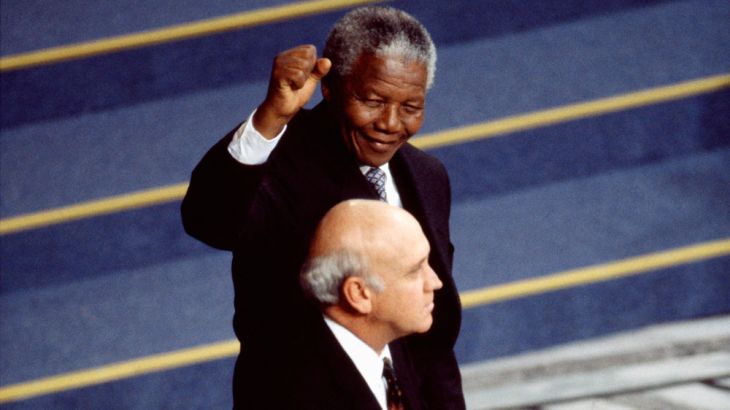
Nelson Mandela and FW de Klerk: Enemies for peace
Insight into the rivalry of the two men who helped end apartheid and shape a new multi-racial democracy in South Africa.
Editor’s note: This film will be removed on February 13, 2020.
On February 11, 1990, South Africa – and the world – turned its eyes to Victor Verster prison to see Nelson Mandela released after 27 years in captivity.
Keep reading
list of 4 itemsUK passes bill to deport asylum seekers to Rwanda: What’s next?
‘Can’t give them jobs’: Rwandans grapple with fears over UK asylum plan
‘It feels personal’: Residents fight Melbourne tower block demolition plan
Four years later, Mandela and the African National Congress (ANC) would rise to power in a landslide victory against the National Party. He would become South Africa’s first black head of state, uniquely supported by two vice presidents to illustrate the government’s movement in the direction of national unity; they were Thabo Mbeki and Frederik Willem de Klerk (commonly known as FW) of the National Party (NP).
In politics, it happens ... We have divorces and then, later on, you become a bit more mature, you are able to come back; and you might not be in love but if you find friendship again, you go through thick and thin. In politics and struggle, we see this all the time: And it happened very much with Mandela and de Klerk.
History seemed to place Mandela and de Klerk on a collision course that put them in the centre of one of the great political turnarounds of the 20th century – the dissolution of apartheid and recognition of the black right to govern South Africa.
However, the two leaders, though joint in purpose eventually, were often at odds with their respective political views.
Mandela founded South Africa’s first black law firm and his name has always been synonymous with the ANC. However, after initially joining the party and leading the Youth League arm for a decade, Mandela grew weary of the lack of change resulting from the ANC’s peaceful ways.
In 1960, following worldwide condemnation of the Sharpeville Massacre, where dozens of peaceful protesters were shot down by armed policemen outside the Sharpeville police station, Mandela founded the armed wing of the ANC, formally known as “Spear of the Nation” and nicknamed “MK”.
On December 16, 1961, the MK announced its creation with a series of bombings intended to place pressure on the government. Mandela viewed this as the best way to provoke a reaction without any casualties.
Less than a year later, he was arrested alongside fellow activist Cecil Williams. The arrest would lead to a two-year trial and Mandela’s eventual sentencing to a lifetime in prison.
On the opposing side of the political spectrum, de Klerk had a reputation for conservatism for the majority of his career. His father, Johannes de Klerk, was a senior National Party politician and his family was heavily embroiled in the growth and development of the NP.
It was de Klerk, however, who momentarily abandoned his views in order to try and end apartheid and ease the deadlock that had crippled South Africa for decades.
Upon then-President Pieter Botha’s resignation due to illness, de Klerk was elected to a full five years as state president.
“I think de Klerk, when he took over as president in 1989, was faced with a choice. He knew that the country’s economy was in really deep trouble. He knew that we were almost facing a civil war inside the country,” says journalist Max du Preez.
“Was he going to do more apartheid, more repression, more police, more military, destroy the economy, getting to a civil war … or was he going to be the historical figure that ended all that? I think the Berlin Wall helped him a lot because it was a strong argument to use to say, ‘We had to fight ANC because they were communists. But now communism is dead so we can talk to them,’ which made the message easier to accept by the white people,” du Preez adds.
In 1993, Mandela and de Klerk jointly received the Nobel Peace prize. They were credited with accomplishing a political miracle – the transformation of their country into a multi-racial democracy without civil war. The transfer of power was fraught with difficulty and although their political rivalry spilled over into the public arena, the relative peace afforded to South Africa was undeniable.
Timeline
This timeline displays key moments in the relationship between Nelson Mandela, the iconic leader of the ANC, and FW de Klerk, the last white president of South Africa, as they worked together to put an end to apartheid.